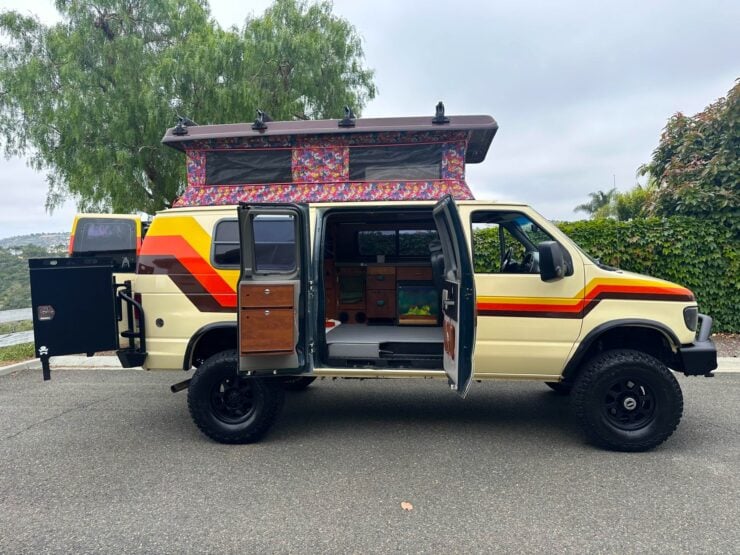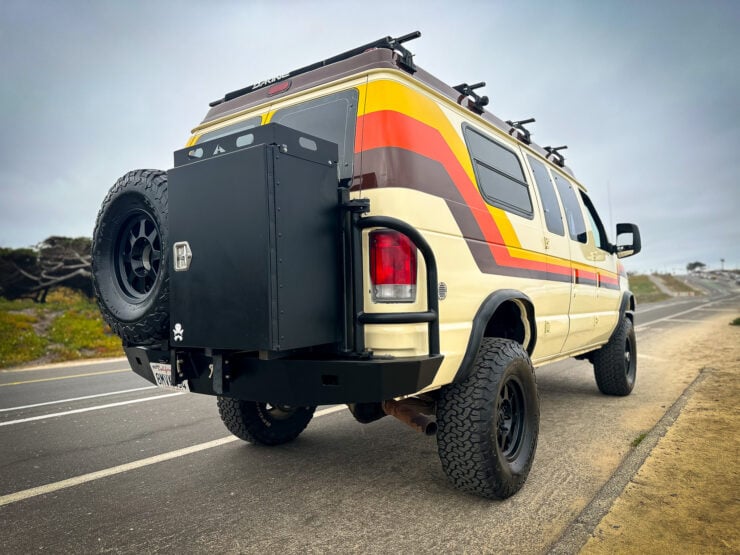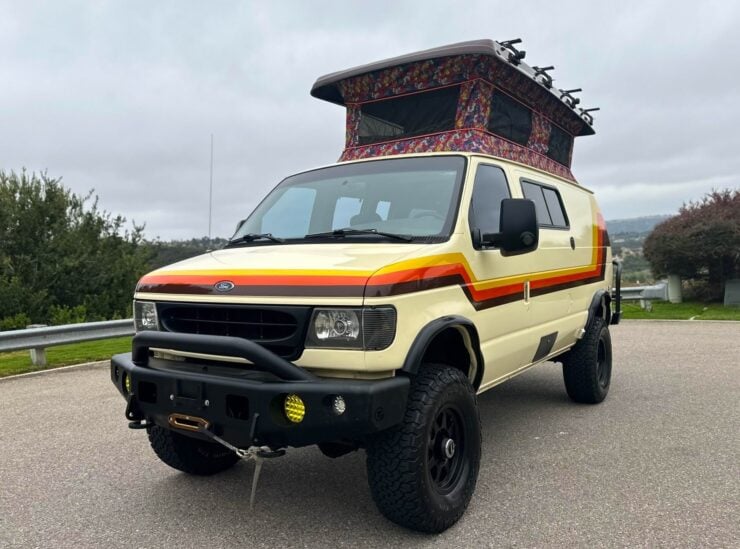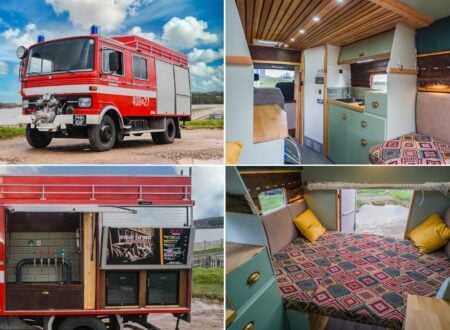This Ford E-350 4×4 is powered by a 6.8 liter Triton V10 producing 305 bhp and 420 lb ft of torque. It was given a camper conversion by Sportsmobile West and it now includes comfortable living space for up to four people in the back.
With its elevated ground clearance and dual-range equipped four-wheel drive system, this E-350 Sportsmobile Camper is ideally suited to adventures both on and off road. It has a pop-top roof with an additional double bed, a sink with running water, a fridge, and ample cupboard space.
Fast Facts – A Ford E-350 4×4 Sportsmobile Camper
- This is a 1998 Ford E-350 4×4 converted into a camper by Sportsmobile West. It’s powered by a 6.8 liter Triton V10 engine, producing 305 bhp and 420 lb ft of torque. The van underwent a 4×4 conversion using components from a period F-series pickup, including lifted suspension, a dual-range transfer case, and front/rear live axles.
- Sportsmobile, founded in 1961 by Curtis and Charles Borskey, pioneered professional camper van conversions in the United States. The company’s early success led to collaborations with Volkswagen and Ford, converting their vans into campers for dealership sales. Sportsmobile expanded throughout the 1960s and 1970s, riding the wave of the van movement’s popularity. By 1989, they had plants in three states and had become one of the largest van-based RV companies in the nation, a status they maintain today.
- The Triton V10 engine, developed by Ford, was based on their Modular V8 platform with two additional cylinders. Initially created for commercial vehicles, there were secret programs to develop high-performance versions for the Ford GT supercar and Mustang, including a 7.0 liter Mustang Boss variant to compete with the Dodge Viper. However, these performance versions never reached production. The Triton V10 remained a staple in truck engine bays from 1997 to 2021, with later versions featuring 30 valves and producing up to 362 bhp.
- The camper conversion by Sportsmobile West includes a pop-top roof for additional headroom and an elevated double bed. The interior features cupboard space, a sink with running water, a fridge, and a solar panel on the roof. The van is equipped with a house battery and inverter. Externally, it has aftermarket bumpers, a winch, a rear-mounted spare tire, and retro graphics. The vehicle is now being offered for sale in Vista, California, with service records and a clean title.
The Story Of Sportsmobile
Sportsmobile was founded all the way back in 1961 by brothers Curtis and Charles Borskey, initially working out of El Paso, Texas. They were one of the first truly professional camper van conversion companies in the United States, and remarkably they’re still operating today, now with locations across the country.


Shortly after the first Sportsmobile designs went on sale the company received a phone call from Volkswagen of America enquiring about sub-contracting them to fit out Volkswagen Type 2 vans as campers, which would then be sold through VW dealerships around the USA.
These early VW Sportsmobile conversions proved popular, so popular in fact that Ford sat up and took notice. Just a year later Sportsmobile had been contracted by Ford to work out of their Lorain, Michigan plant installing camper kits in brand new Ford vans for sale though Ford dealerships.
As the 1960s progressed Volkswagen of America would end their contract with Sportsmobile, but undeterred the company simply began building selling converted Type 2 Vans directly to Volkswagen distributors, cutting out Volkswagen of America altogether.
The company continued to expand throughout the 1960s and 1970s, as the van movement picked up steam and evolved from the Hippie Movement of the 1960s, into the more airbrushed-shag-carpeted custom van world of the 1970s.
By 1989 Sportsmobile would have plants in Huntington, Indiana, in Austin, Texas, and in Fresno, California. They had become one of the largest van-based RV companies in the nation, and they still enjoy this accolade today over 25 years later.
The Ford E-350 4×4 Sportsmobile Camper Shown Here
The 1998 Ford E-350 you see here has been given a four-wheel drive conversion from a period F-series 4×4 pickup, it also has lifted suspension, a dual range transfer case, and live axles front and back on rear leaf springs and front coils.


These 4×4 conversions are popular and made relatively straightforward due to the fact that the Ford E-series vans and F-series pickup trucks of this generation shared the same chassis underpinnings.
This E-350 is powered by the Ford Triton V10, workhorse of an engine that would become the American V10 with by far the highest production numbers – some estimates put the final number at over one million units.
The Triton V10
The Triton V10 was built on the Ford Modular V8 platform, engineers essentially added two cylinders to the block due to the fact that they couldn’t increase displacement any other way. This meant that many internal parts could be retained, vastly reducing both the cost of development and the timeline.
The Triton was developed as a power unit for commercial vehicles, trucks, vans, etc. But there were programs at Ford, kept hidden from public view for many years, to create high-performance versions of the V10 for use in both the Ford GT supercar, and the Ford Mustang – including a special 7.0 liter version for a proposed Mustang Boss variant that would compete with the V10 Dodge Viper.
Sadly, none of these high-performance versions of the Triton V10 would make it into production, and as a result the engine would remain a fixture of truck engine bays from 1997 until it left production in 2021.


The Ford E-350 could be ordered with the 6.8 liter Triton V10, initially the single overhead cam version with 20 valves (two per cylinder), then with the 30 valve version from 2005 onwards. This engine initially produced 305 bhp and 420 lb ft of torque, with the later 30 valve engine making up to 362 bhp and 457 lb ft of torque.
The 1998 Ford E-350 shown in this article is powered by the 20 valve 6.8 liter V10 which is mated to a heavy-duty 4-speed automatic transmission and a dual range transfer case sending power forwards and backwards to the live axles.
The Camper Conversion
A camper conversion was completed by the specialists at Sportsmobile West under prior ownership. It’s a relatively minimalist conversion and the paintwork might not be to everyone’s taste – but this sort of things can be quickly changed by the new owner if they wish.
The pop-top offers additional standing headroom, and there’s a bed panel that can be inserted to make a platform for an elevated double bed. There is cupboard space, a sink with running water, a fridge, a solar panel on the roof, and a house battery with an inverter.


Up front this E-350 has black leather captain’s chairs with folding arm rests, power steering, power windows and locks, air conditioning, and a Kenwood touchscreen head unit. Externally the van has aftermarket bumpers, a winch, a rear-mounted spare tire, a storage box, and retro graphics down either side of the body work.
The van is now being offered for sale out of Vista, California on Bring a Trailer with service records, an accident-free Carfax report, and a clean California title in the seller’s name. If you’d like to read more about it or register to bid you can visit the listing here.























Images courtesy of Bring a Trailer








